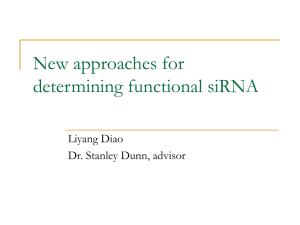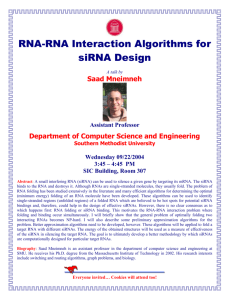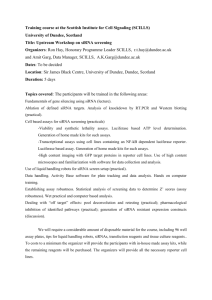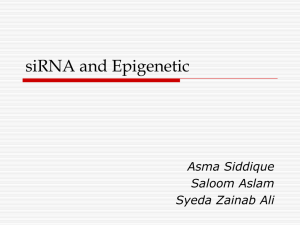Unlocking the potential of RNA interference as a therapeutic tool Abstract
advertisement
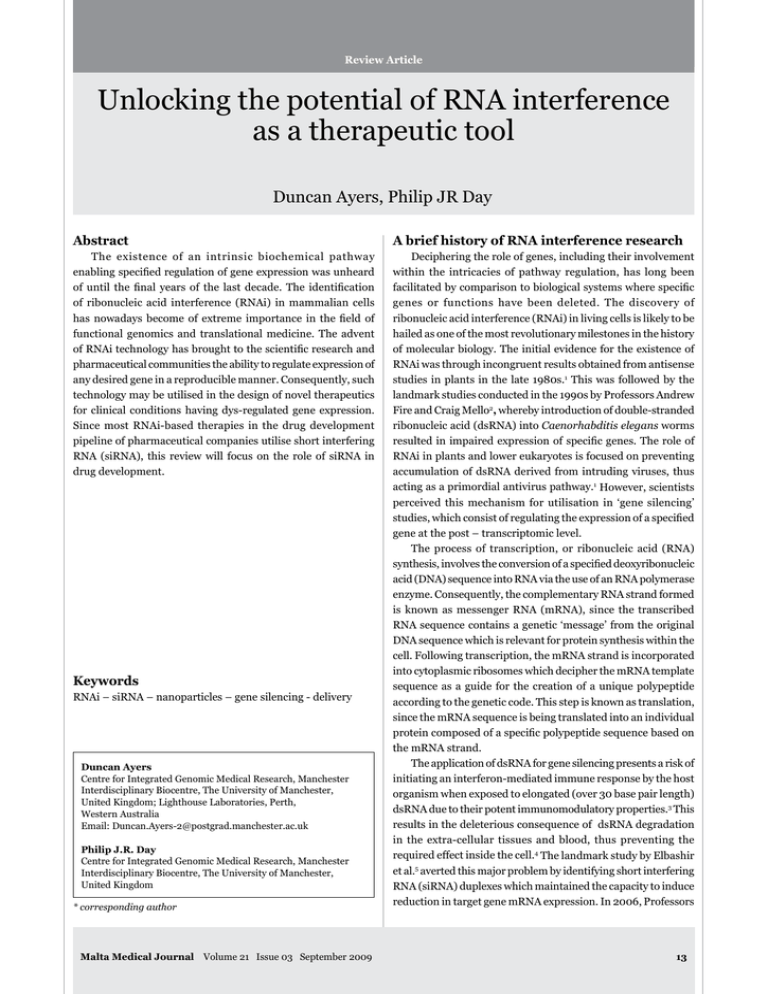
Review Article Unlocking the potential of RNA interference as a therapeutic tool Duncan Ayers, Philip JR Day Abstract A brief history of RNA interference research The existence of an intrinsic biochemical pathway enabling specified regulation of gene expression was unheard of until the final years of the last decade. The identification of ribonucleic acid interference (RNAi) in mammalian cells has nowadays become of extreme importance in the field of functional genomics and translational medicine. The advent of RNAi technology has brought to the scientific research and pharmaceutical communities the ability to regulate expression of any desired gene in a reproducible manner. Consequently, such technology may be utilised in the design of novel therapeutics for clinical conditions having dys-regulated gene expression. Since most RNAi-based therapies in the drug development pipeline of pharmaceutical companies utilise short interfering RNA (siRNA), this review will focus on the role of siRNA in drug development. Deciphering the role of genes, including their involvement within the intricacies of pathway regulation, has long been facilitated by comparison to biological systems where specific genes or functions have been deleted. The discovery of ribonucleic acid interference (RNAi) in living cells is likely to be hailed as one of the most revolutionary milestones in the history of molecular biology. The initial evidence for the existence of RNAi was through incongruent results obtained from antisense studies in plants in the late 1980s.1 This was followed by the landmark studies conducted in the 1990s by Professors Andrew Fire and Craig Mello2, whereby introduction of double-stranded ribonucleic acid (dsRNA) into Caenorhabditis elegans worms resulted in impaired expression of specific genes. The role of RNAi in plants and lower eukaryotes is focused on preventing accumulation of dsRNA derived from intruding viruses, thus acting as a primordial antivirus pathway.1 However, scientists perceived this mechanism for utilisation in ‘gene silencing’ studies, which consist of regulating the expression of a specified gene at the post – transcriptomic level. The process of transcription, or ribonucleic acid (RNA) synthesis, involves the conversion of a specified deoxyribonucleic acid (DNA) sequence into RNA via the use of an RNA polymerase enzyme. Consequently, the complementary RNA strand formed is known as messenger RNA (mRNA), since the transcribed RNA sequence contains a genetic ‘message’ from the original DNA sequence which is relevant for protein synthesis within the cell. Following transcription, the mRNA strand is incorporated into cytoplasmic ribosomes which decipher the mRNA template sequence as a guide for the creation of a unique polypeptide according to the genetic code. This step is known as translation, since the mRNA sequence is being translated into an individual protein composed of a specific polypeptide sequence based on the mRNA strand. The application of dsRNA for gene silencing presents a risk of initiating an interferon-mediated immune response by the host organism when exposed to elongated (over 30 base pair length) dsRNA due to their potent immunomodulatory properties.3 This results in the deleterious consequence of dsRNA degradation in the extra-cellular tissues and blood, thus preventing the required effect inside the cell.4 The landmark study by Elbashir et al.5 averted this major problem by identifying short interfering RNA (siRNA) duplexes which maintained the capacity to induce reduction in target gene mRNA expression. In 2006, Professors Keywords RNAi – siRNA – nanoparticles – gene silencing - delivery Duncan Ayers Centre for Integrated Genomic Medical Research, Manchester Interdisciplinary Biocentre, The University of Manchester, United Kingdom; Lighthouse Laboratories, Perth, Western Australia Email: Duncan.Ayers-2@postgrad.manchester.ac.uk Philip J.R. Day Centre for Integrated Genomic Medical Research, Manchester Interdisciplinary Biocentre, The University of Manchester, United Kingdom * corresponding author Malta Medical Journal Volume 21 Issue 03 September 2009 13 Fire and Mello both received the Nobel Prize in Medicine for their research efforts. This research field rapidly attracted the attention of major pharmaceutical companies, finding the appeal of the RNAi pathway as an effective and safe therapeutic measure.6 The main potential advantage offered by RNAi technology to the research and pharmaceutical community is the capacity to regulate expression of any desired gene in a robust manner, thus making it valuable as a novel therapy for all clinical conditions based on dys-regulated gene expression. Previous studies involved the use of antisense oligonucleotides, although the pharmacokinetic properties of such compounds is limited, resulting in decreased potency.7 Additionally, RNAi also proves to be of enormous help in the field of functional genomics, whereby scientists were previously dependant on murine ‘knock-out’ models in their investigations, which may prove to have flaws.8 Moreover, ‘knock-out’ mice are extremely costly and time consuming to develop, together with the ethical issues involved with utilising animals in medical research. RNAi research additionally encompasses a spectrum of pathway relevant dsRNA-based effector molecules such as siRNAs and micro RNAs (miRNAs), involved in evoking the desired decrease in target gene expression levels.9,10 It must be stated however, that miRNAs form part of an innate intracellular pathway designed for control of gene expression11, as opposed to siRNAs which are synthetic. Since the many RNAi-based therapies in the drug development pipeline of pharmaceutical companies utilise siRNA, this review will focus on the role of siRNA in drug development. siRNA mode of action The siRNA molecule consists of a 21-23 nucleotide dsRNA duplex having two-nucleotide 3’ overhangs (Figure 1).12 The two strands forming the siRNA molecule are known as the passenger and guide strands respectively.13 The passenger strand contains the sense sequence for the target mRNA region which requires cleavage, whilst the guide strand bears the antisense sequence which is complementary to the target mRNA (Figure 2).12 Figure 1: Diagram of a siRNA duplex, illustrating the sense passenger (black) and antisense guide (grey) strand. The seed region is a unique sequence present between, and inclusive of the second and seventh base of the guide strand 14 Once the siRNA duplex successfully enters the target cell cytoplasm, by crossing the cell membrane,14 it is recognised and attached to an Argonaute protein (AGO2) located within the RNA-induced Silencing Complex (RISC).15,16 Consequently, only the guide strand is utilised by AGO2 / RISC to seek and bind the target complementary mRNA present in the cytoplasm by complementarity.16 Finally, the Argonaute protein present in the complex cleaves the target mRNA into two segments.16 The RISC complex is then free to pursue other target mRNA strands displaying the complementary sequence for the siRNA guide strand. This pathway is formally defined as Post Transcriptional Gene Silencing (PTGS).17 Importance of siRNA in clinical therapeutics The siRNA-mediated PTGS pathway present in mammalian cells18 tantalisingly represents an ideal opportunity for drug development scientists to exploit the silencing of specific disease-related gene expression. Such genes can be critical in the pathogenesis and/or aggravation of a wide spectrum of clinical conditions, some of which might prove to be life-threatening to the patient. Therefore, the siRNA-based therapy is a highly attractive tool in translational medicine research, due to its simplicity and robustness in its mode of action and through its potential therapeutic effectiveness. Pharmaceutical and biotech companies are presently in the process of developing novel siRNA-based therapies in their product pipeline portfolio (Table 1). Calando Pharmaceuticals (USA) are investigating the utilisation of siRNA for controlling DNA replication, with the resultant effect of targeting conditions such as cancer.19 The siRNA is designed to target the M2 subunit of ribonucleotide reductase, which is an enzyme involved in the assembly of deoxyribonucleotides for DNA synthesis.19 Quark Pharmaceuticals (USA) is currently developing a siRNA treatment against acute renal failure by means of shortterm silencing of the human p53 gene.20 The role of p53 is Figure 2: Simplified representation siRNA mode of action in the cell cytoplasm of the cell hosting the target gene designated for silencing Malta Medical Journal Volume 21 Issue 03 September 2009 primarily that of initiating the apoptotic pathways in damaged cells following DNA damage or other cellular stress stimuli.21 Other siRNA therapies undergoing clinical trials are focused on Age-related Macular Degeneration (AMD), which is a potentially serious condition due to choroidal neovascularization (CNV) in the macular region of the eye, leading to severe, long-term loss of vision in elderly patients.22 Opko Health Inc. (USA) have the siRNA drug candidate bevasiranib which is a siRNA duplex complementary to key sequences of the Vascular Endothelial Growth Factor (VEGF) gene, and is currently undergoing Phase III clinical trials.23 VEGF is an aggravating factor for the induction of CNV in the elderly patient22 and is thus an ideal target gene for siRNA silencing (or ‘knockdown’). Sirna therapeutics Inc (USA) also has a siRNA candidate drug which targets Vascular Endothelial Growth Receptor 1 (VEGFR1).24 Alnylam Pharmaceuticals (USA) has recently initiated Phase I clinical trial of the first inhalable siRNA-based therapy, which is designed for silencing specific genes in respiratory syncitial virus infection in the lungs.25 TransDerm (USA) is another pharmaceutical company which has embarked on developing a siRNA-based drug candidate, which is capable of silencing the mutant variants of the keratin genes K6a, K6b, K16 and K17.26 These mutant keratin genes, once expressed at the transcriptomic level, are the causative factors for the pathogenesis of pachyonychia congenita.26 Figure 3: Some challenges facing siRNA delivery into target cells. Recognition by circulating interferon, degradation by serum nucleases and difficulty in traversing target cell membranes (Diagram reproduced by courtesy of Dr. A. Nasti, Federico II University, Naples) Malta Medical Journal Volume 21 Issue 03 September 2009 Multiple siRNAs can also be designed and simultaneously targeted against a spectrum of oncogenes27 in the case of cancer, for the purpose of enhancing the effectiveness of the siRNA therapy, by inducing multiple gene knockdown effects in the target tissues. The study carried out by Kunze et al. was successful in inhibiting the expression of several anti-apoptotic genes involved in bladder cancer cells. 27 Multiple siRNA therapies can also prove to be effective against infective agents present in the host mammalian cell, which have the capacity to evade individual therapies by mutational escape.28 A typical example is the use of several siRNAs directed against specific genes aiding the development of the Human Immunodeficiency Virus 1 (HIV-1) at varying stages, thus ensuring that HIV-1 post-transcriptional protein synthesis is severely impaired and there is only a marginal possibility through mutational escape by the virus.28 Gene silencing can also form part of a combination therapy with conventional drugs already possessing clinical trials approval.29 The study led by Lentini et al. involved the administration of the conventional chemotherapeutic agent vincristine together with a siRNA duplex targeted against the Aurora-A gene, which plays an important role in centrosome Figure 4: Illustration of the off target effect of RISC binding on siRNA. Step 1; two identical siRNA duplexes having a sense (black) and antisense (grey) strand for a unique sequence in target gene A, with both duplexes present inside target cell cytoplasm. Step 2; RISC approaches siRNAs. Step 3; RISC approaches siRNA duplex, thus incorporating the antisense or sense strand as the siRNA guide strand respectively. Steps 4 and 5 (Left); siRNA / RISC identify target mRNA sequence on gene A and allows for mRNA cleavage as predicted. Steps 4 and 5 (Right); due to the sense strand from the duplex being incorporated as the guide strand in the resultant siRNA / RISC, the latter targets the mRNA sequence for an unrelated gene Z which is also present in the target cell cytoplasm, brining about its mRNA cleavage and consequent off-target effects at the posttranscriptional level 15 development and cell cycle progression in human cells.29 The study highlighted the synergic effect of combining both siRNA and conventional anti-neoplastic therapy on human colon cancer cells which were previously rendered resistant to other chemotherapeutic agents due to Aurora-A over-expression.29 Challenges awaiting effective siRNA therapeutics Unfortunately, the research and development of siRNA ‘magic bullets’ is never straightforward and many hurdles have to be dealt with before an effective drug candidate can be deemed to obtain all the necessary requirements for commercialisation. Major concerns regarding systemic administration of siRNA duplexes in sufficient levels to reach target tissues still need to be resolved (Figure 3). Once introduced into the bloodstream, siRNA effectors are exposed to a multitude of threats during their transport to the target tissue, such as the risk of degradation by nucleases30 present in the blood and initiation of interferonmediated immune responses.3 Additionally, the siRNA duplex must have the capacity to be successfully taken up by the target tissue cells, which might prove to be problematic due to the structural nature of the siRNA duplex.30 One of the biggest obstacles involved in siRNA therapeutics research is a threat that the siRNA duplex silences the expression of genes which are not being targeted, but which may have highly similar signature mRNA sequences, or alternatively the sense strand being inadvertently utilised as the guide strand in the siRNA/RISC model (Figure 4). Such off-target effects can be split into two main problems, the first one being the ability of an individual siRNA duplex to induce mRNA degradation of non-target genes.31 Secondly, siRNA duplexes might bind to nontarget transcripts having three or four mismatches in sequence complementarity and thus affect translation of the off – target gene, with a consequent alteration in protein synthesis for the specific off – target gene.31 At present, the siRNA design strategies required to minimise off-target effects are quite limited. However, the study performed by Jackson et al.32 demonstrated that the seed region of the siRNA guide strand sequence (positions 2 to 7) must be uniquely complementary to the target gene mRNA sequence for minimising off – target effects (Figure 1). Additionally, scientific research companies and academic groups involved in siRNA research have developed free online applications which allow the researcher to design the best siRNA duplex sequences in order to knock-down his or her target gene of choice, with minimal off – target effects.33,34 The tools apply mathematical algorithms which aim to minimise such off - target effects and maximise gene knockdown capacity by any one siRNA duplex. Luckily, the research themes focusing on efficient siRNA systemic delivery systems look much more promising (Table 2). If the siRNA effector is successfully ‘shielded’ during its transport inside the bloodstream, the risk of nuclease – mediated degradation may be lowered to negligible levels, thus enhancing the bioavailability of the intact siRNA therapeutic agent. Studies investigating chemical modifications of the siRNA duplex, for the purpose of avoiding siRNA systemic recognition by nucleases and interferon, have proved to be a successful strategy.14 Other delivery systems involve the utilisation of liposomes as a means of protecting the siRNA duplex against systemic degradation.35,36 Attachment of target tissue specific monoclonal antibodies to liposome delivery systems enables the siRNA effector to home onto the therapeutic site with enhanced success and reducing effects on other tissues.37 However, monoclonal antibodies might also be successfully bound to non–encapsulated effector siRNA duplex through the utilisation of an intermediate protamine molecule.38 This method was effective in silencing Hepatitis B Virus (HBV) gene expression, by adopting bespoke siRNA effectors linked to monoclonal antibodies targeting the hepatitis B surface antigen (HBsAg).38 Another efficient siRNA delivery method entails the linking of siRNA duplexes to target tissue specific aptamer Table1: List of siRNA based therapeutics currently under development Company Target Gene Indication of Treatment Development Phase Status Reference/s Calando Pharmaceuticals M2 subunit of ribonucleotide reductase Solid Tumour Cancer I 19 Quark Pharmaceuticals P53 Acute Renal Failure I 20 Opko Health Inc. Vascular Endothelial Growth Factor (VEGF) Age-related Macular Degeneration III 23 Sirna Therapeutics Inc. Vascular Endothelial Age-related Macular Growth Receptor 1 (VEGFR1) Degeneration II 24 Alnylam Pharmaceuticals Respiratory Syncytial Virus (RSV) genes Respiratory Syncytial Virus II 25 TransDerm Inc. Pachyonychia Congenita I 26 mutant keratin genes K6a, K6b, K16 and K17 Malta Medical Journal Volume 21 Issue 03 September 2009 17 Table 2: List of siRNA delivery systems currently being investigated for use in siRNA therapies Delivery Method References Chemically modified siRNA No 14 Liposome / siRNA complexes No 35, 36 Protamine / Antibody - bound siRNA Yes 38 Aptamer / siRNA chimera Yes 39 Nanoparticle encapsulated siRNA No 41 oligonucleotides to form siRNA – aptamer chimeras.39 A recent study applying such a targeted siRNA delivery system was that conducted by Zhou et al. which concerned the development of siRNAs in HIV-1 therapy.40 The study involved the attachment of siRNA duplexes having guide strands complementary to tat/ rev mRNA, linked to an aptamer which is specific for gp120, a characteristic envelope glycoprotein expressed by all HIV-1 infected host cells.40 The use of chitosan nanoparticles for the delivery of siRNAs safely to the target tissue is also being actively studied at present.41 Such nanoparticles, loaded with siRNAs directed against Tumour Necrosis Factor (TNF), have already shown to be successful in providing sustained knockdown of the TNF gene in murine arthritis models.41 However, all such therapies require repeated dosing as the siRNAs act on continually generated mRNA. Conclusions The concept of exploiting a generic pathway involved in controlling mammalian gene expression to dissect and comprehend purpose is undoubtedly alluring for all researchers in translational medicine and functional genomics. The advantage that any siRNA therapy offers is the specificity to target mRNA. Additionally, if the siRNA design is totally unique to the target mRNA designated for silencing, off - target effects can be minimised to negligible levels. The consequent discovery of such a pathway in the form of RNAi has now opened the doors for a new era of drug design, one which has the capacity to pinpoint the genes responsible for disease and consequently minimise their damaging effects on the individual patient. Furthermore, the possibility of severe adverse effect development is low, particularly if the siRNA therapy involves the use of a targeted delivery system which directs the siRNA effector molecule solely to the diseased tissue. Presently, we are only just starting to unravel the motives behind the existence of RNAi pathways. Undoubtedly, RNAi may be acclaimed as one of the most potent methods for mammalian gene regulation at the transcriptomic level, one which also 18 Tissue - Specific targeting? blends in harmoniously with many other cellular and tissue pathways related to mammalian gene expression together with consequent proteomic and metabolomic processes. However, the field of RNAi therapeutics is very much in its early days, with intense research focusing on optimising a siRNA therapy with a delivery system that proves to be effective in silencing the target gene, with the added property of minimising the risk of siRNA – induced off - target effects. As the first decade of RNAi draws to a close, the next ten years commences with positive hope for the field of RNAi therapeutics. Focused research in siRNA design will help in developing siRNA duplexes with unique specificity for their target gene, thus rendering off target effects minimal. Advances in siRNA delivery systems will ensure that the siRNA will exert its gene silencing property at maximum efficiency only inside the target cells expressing disease-specific transcripts designated for knockdown. Optimisation of delivery systems might also prolong the duration of siRNA silencing effects, through the development of sustained release pharmaceutical formulations. In addition, the field of miRNA research bears with it a great potential for discovering hidden mechanisms by which noncoding RNA sequences are being utilised for the scope of gene regulation, both in normal cellular processes and also in disease pathways, resulting in the identification of novel drug targets for future RNAi based therapeutics. Ultimately, the development of RNAi ‘magic bullets’ will respectively possess characteristics of unambiguous elimination of disease-specific transcripts from specific cell types within the individual patient. References 1. Baulcombe D. Overview of RNA interference and related processes. In: Frederick M Ausubel, et al. editors. Current protocols in molecular biology. 2003;Chapter 26:Unit 26 1. 2. Fire A, Xu S, Montgomery MK, Kostas SA, Driver SE, Mello CC. Potent and specific genetic interference by double-stranded RNA in Caenorhabditis elegans. Nature. 1998;391:806-11. 3. Judge A, MacLachlan I. Overcoming the innate immune response to small interfering RNA. Human gene therapy. 2008;19:111-24. 4. Bagasra O, Prilliman KR. RNA interference: the molecular immune system. Journal of molecular histology. 2004;35:545-53. Malta Medical Journal Volume 21 Issue 03 September 2009 5. Elbashir SM, Harborth J, Lendeckel W, Yalcin A, Weber K, Tuschl T. Duplexes of 21-nucleotide RNAs mediate RNA interference in cultured mammalian cells. Nature. 2001;411:494-8. 6. Howard K. Unlocking the money-making potential of RNAi. Nature biotechnology. 2003;21:1441-6. 7. Geary RS. Antisense oligonucleotide pharmacokinetics and metabolism. Expert opinion on drug metabolism & toxicology. 2009;5:381-91. 8. Eisener-Dorman AF LD, Bolivar VJ. Cautionary insights on knockout mouse studies: The gene or not the gene? Brain Behav Immun. 2008;Epub ahead of print.. 9. Martin SE, Caplen NJ. Applications of RNA interference in mammalian systems. Annual review of genomics and human genetics. 2007;8:81-108. 10.Campbell TN, Choy FY. RNA interference: past, present and future. Current issues in molecular biology. 2005 ;7:1-6. 11. Ruan K, Fang X, Ouyang G. MicroRNAs: Novel regulators in the hallmarks of human cancer. Cancer letters. 2009 May 21. Epub ahead of print. 12.Shrivastava N, Srivastava A. RNA interference: an emerging generation of biologicals. Biotechnology journal. 2008;3:339-53. 13.Leuschner PJ, Ameres SL, Kueng S, Martinez J. Cleavage of the siRNA passenger strand during RISC assembly in human cells. EMBO reports. 2006;7:314-20. 14.Watts JK, Deleavey GF, Damha MJ. Chemically modified siRNA: tools and applications. Drug discovery today. 2008;13:842-55. 15.Caplen NJ, Mousses S. Short interfering RNA (siRNA)-mediated RNA interference (RNAi) in human cells. Annals of the New York Academy of Sciences. 2003;1002:56-62. 16.Jinek M, Doudna JA. A three-dimensional view of the molecular machinery of RNA interference. Nature. 2009;457:405-12. 17. Morris KV. Therapeutic potential of siRNA-mediated transcriptional gene silencing. BioTechniques. 2006 Apr;Suppl:7-13. 18.McManus MT, Sharp PA. Gene silencing in mammals by small interfering RNAs. Nature reviews. 2002;3:737-47. 19.Heidel JD, Liu JY, Yen Y, Zhou B, Heale BS, Rossi JJ, et al. Potent siRNA inhibitors of ribonucleotide reductase subunit RRM2 reduce cell proliferation in vitro and in vivo. Clin Cancer Res. 2007;13:220715. 20.Molitoris BA, Dagher PC, Sandoval RM, Campos SB, Ashush H, Fridman E, et al. siRNA Targeted to p53 Attenuates Ischemic and Cisplatin-Induced Acute Kidney Injury. J Am Soc Nephrol. 2009;20:1754-64.. 21.Zheleva DI, Lane DP, Fischer PM. The p53-Mdm2 pathway: targets for the development of new anticancer therapeutics. Mini reviews in medicinal chemistry. 2003;3:257-70. 22.Grisanti S, Tatar O. The role of vascular endothelial growth factor and other endogenous interplayers in age-related macular degeneration. Progress in retinal and eye research. 2008;27:372-90. 23.Dejneka NS, Wan S, Bond OS, Kornbrust DJ, Reich SJ. Ocular biodistribution of bevasiranib following a single intravitreal injection to rabbit eyes. Molecular vision. 2008;14:997-1005. 24.Shen J, Samul R, Silva RL, Akiyama H, Liu H, Saishin Y, et al. Suppression of ocular neovascularization with siRNA targeting VEGF receptor 1. Gene therapy. 2006;13:225-34. 25.Durcan N, Murphy C, Cryan SA. Inhalable siRNA: potential as a therapeutic agent in the lungs. Molecular pharmaceutics. 2008; 5:559-66. 26.Hickerson RP, Smith FJ, McLean WH, Landthaler M, Leube RE, Kaspar RL. SiRNA-mediated selective inhibition of mutant keratin mRNAs responsible for the skin disorder pachyonychia congenita. Annals of the New York Academy of Sciences. 2006;1082:56-61. 27.Kunze D, Wuttig D, Fuessel S, Kraemer K, Kotzsch M, Meye A, et al. Multitarget siRNA inhibition of antiapoptotic genes (XIAP, BCL2, BCL-X(L)) in bladder cancer cells. Anticancer research. 2008;28:2259-63. 28.Kirchhoff F. Silencing HIV-1 In Vivo. Cell. 2008;134:566-8. 29.Lentini L, Amato A, Schillaci T, Insalaco L, Di Leonardo A. Aurora-A transcriptional silencing and vincristine treatment show a synergistic effect in human tumor cells. Oncology research. 2008;17:115-25. Malta Medical Journal Volume 21 Issue 03 September 2009 30.White PJ. Barriers to Successful Delivery of Short Interfering Rna after Systemic Administration. Clinical and experimental pharmacology & physiology. 2008;35:1371-6. 31.Jackson AL, Linsley PS. Noise amidst the silence: off-target effects of siRNAs? Trends Genet. 2004;20:521-4. 32.Jackson AL, Burchard J, Schelter J, Chau BN, Cleary M, Lim L, et al. Widespread siRNA “off-target” transcript silencing mediated by seed region sequence complementarity. RNA. 2006;12:1179-87. 33.Gong W, Ren Y, Zhou H, Wang Y, Kang S, Li T. siDRM: an effective and generally applicable online siRNA design tool. Bioinformatics. 2008;24:2405-6. 34.Lu ZJ, Mathews DH. OligoWalk: an online siRNA design tool utilizing hybridization thermodynamics. Nucleic acids research. 2008 Jul 1;36(Web Server issue):W104-8. 35.Auguste DT, Furman K, Wong A, Fuller J, Armes SP, Deming TJ, et al. Triggered release of siRNA from poly(ethylene glycol)-protected, pH-dependent liposomes. J Control Release. 2008;130:266-74. 36.Fenske DB, Chonn A, Cullis PR. Liposomal nanomedicines: an emerging field. Toxicologic pathology. 2008;36:21-9. 37.Liu B. Exploring cell type-specific internalizing antibodies for targeted delivery of siRNA. Briefings in functional genomics & proteomics. 2007;6:112-9. 38.Wen WH, Liu JY, Qin WJ, Zhao J, Wang T, Jia LT, et al. Targeted inhibition of HBV gene expression by single-chain antibody mediated small interfering RNA delivery. Hepatology. 2007;46:84-94. 39.Shaw BR, Moussa L, Sharaf M, Cheek M, Dobrikov M. Boranophosphate siRNA-aptamer chimeras for tumor-specific downregulation of cancer receptors and modulators. Nucleic acids symposium series (2004). 2008(52):655-6. 40.Zhou J, Li H, Li S, Zaia J, Rossi JJ. Novel dual inhibitory function aptamer-siRNA delivery system for HIV-1 therapy. Mol Ther. 2008;16:1481-9. 41.Howard KA, Paludan SR, Behlke MA, Besenbacher F, Deleuran B, Kjems J. Chitosan/siRNA Nanoparticle-mediated TNF-alpha Knockdown in Peritoneal Macrophages for Anti-inflammatory Treatment in a Murine Arthritis Model. Mol Ther. 2009;17(1):162-8. Erratum Farrugia B, Farrugia Sant’Angelo V, Cacciottolo J. Tuberculosis in Malta and the school BCG vaccination programme. MMJ. 2009;21(2):13-17. This article lacked an acknowledgements section which should have read as follows: Acknowledgements The authors would like to acknowledge the advice of Paul EM Fine VMD, PhD Professor of Communicable Disease Epidemiology, London School of Hygiene and Tropical Medicine, as well as all staff, past and present, working in the Chest Unit, Chest Clinic, Health Promotion and Disease Prevention Directorate, Mycobacteriology laboratory services, and the National Statistics Office, for the collection, availability and permission to use their data. 19
